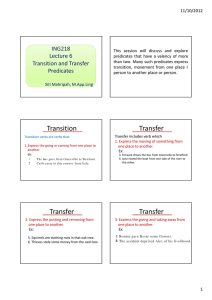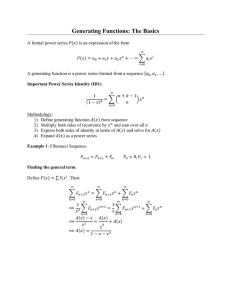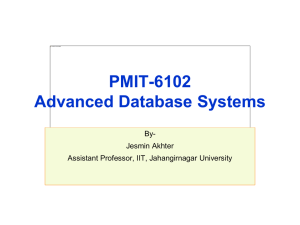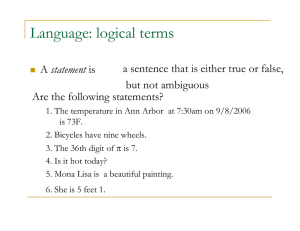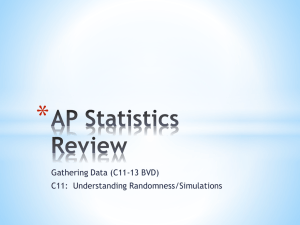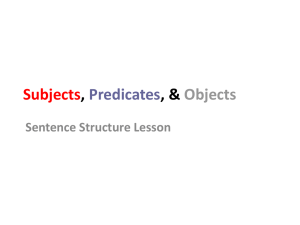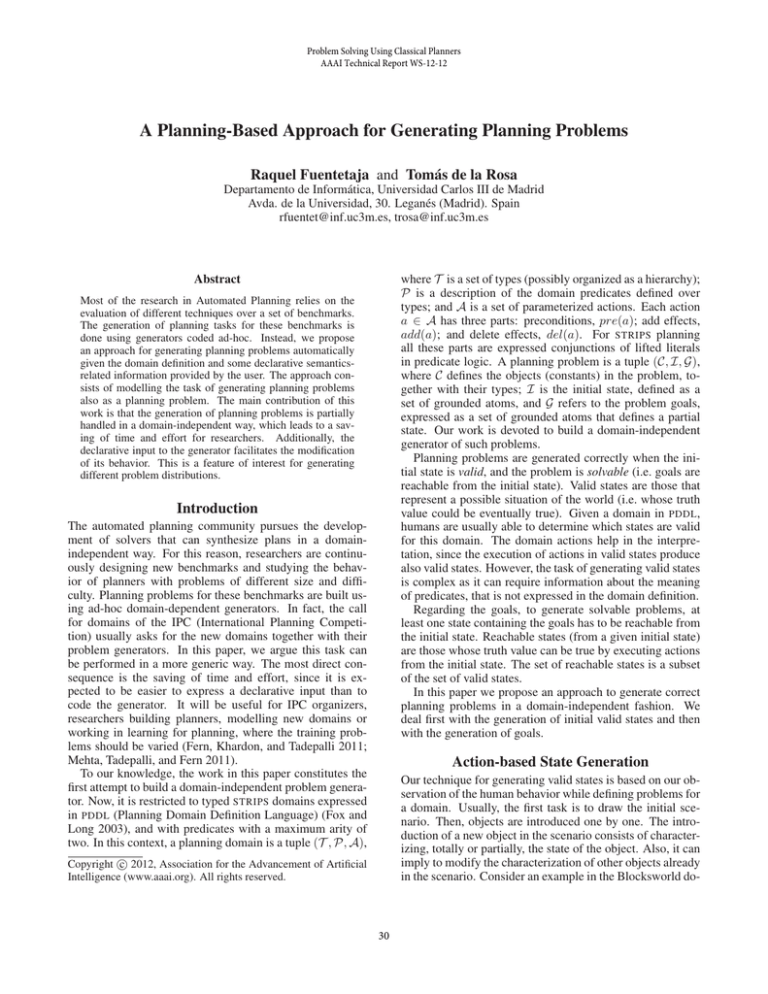
Problem Solving Using Classical Planners
AAAI Technical Report WS-12-12
A Planning-Based Approach for Generating Planning Problems
Raquel Fuentetaja and Tomás de la Rosa
Departamento de Informática, Universidad Carlos III de Madrid
Avda. de la Universidad, 30. Leganés (Madrid). Spain
rfuentet@inf.uc3m.es, trosa@inf.uc3m.es
where T is a set of types (possibly organized as a hierarchy);
P is a description of the domain predicates defined over
types; and A is a set of parameterized actions. Each action
a ∈ A has three parts: preconditions, pre(a); add effects,
add(a); and delete effects, del(a). For STRIPS planning
all these parts are expressed conjunctions of lifted literals
in predicate logic. A planning problem is a tuple (C, I, G),
where C defines the objects (constants) in the problem, together with their types; I is the initial state, defined as a
set of grounded atoms, and G refers to the problem goals,
expressed as a set of grounded atoms that defines a partial
state. Our work is devoted to build a domain-independent
generator of such problems.
Planning problems are generated correctly when the initial state is valid, and the problem is solvable (i.e. goals are
reachable from the initial state). Valid states are those that
represent a possible situation of the world (i.e. whose truth
value could be eventually true). Given a domain in PDDL,
humans are usually able to determine which states are valid
for this domain. The domain actions help in the interpretation, since the execution of actions in valid states produce
also valid states. However, the task of generating valid states
is complex as it can require information about the meaning
of predicates, that is not expressed in the domain definition.
Regarding the goals, to generate solvable problems, at
least one state containing the goals has to be reachable from
the initial state. Reachable states (from a given initial state)
are those whose truth value can be true by executing actions
from the initial state. The set of reachable states is a subset
of the set of valid states.
In this paper we propose an approach to generate correct
planning problems in a domain-independent fashion. We
deal first with the generation of initial valid states and then
with the generation of goals.
Abstract
Most of the research in Automated Planning relies on the
evaluation of different techniques over a set of benchmarks.
The generation of planning tasks for these benchmarks is
done using generators coded ad-hoc. Instead, we propose
an approach for generating planning problems automatically
given the domain definition and some declarative semanticsrelated information provided by the user. The approach consists of modelling the task of generating planning problems
also as a planning problem. The main contribution of this
work is that the generation of planning problems is partially
handled in a domain-independent way, which leads to a saving of time and effort for researchers. Additionally, the
declarative input to the generator facilitates the modification
of its behavior. This is a feature of interest for generating
different problem distributions.
Introduction
The automated planning community pursues the development of solvers that can synthesize plans in a domainindependent way. For this reason, researchers are continuously designing new benchmarks and studying the behavior of planners with problems of different size and difficulty. Planning problems for these benchmarks are built using ad-hoc domain-dependent generators. In fact, the call
for domains of the IPC (International Planning Competition) usually asks for the new domains together with their
problem generators. In this paper, we argue this task can
be performed in a more generic way. The most direct consequence is the saving of time and effort, since it is expected to be easier to express a declarative input than to
code the generator. It will be useful for IPC organizers,
researchers building planners, modelling new domains or
working in learning for planning, where the training problems should be varied (Fern, Khardon, and Tadepalli 2011;
Mehta, Tadepalli, and Fern 2011).
To our knowledge, the work in this paper constitutes the
first attempt to build a domain-independent problem generator. Now, it is restricted to typed STRIPS domains expressed
in PDDL (Planning Domain Definition Language) (Fox and
Long 2003), and with predicates with a maximum arity of
two. In this context, a planning domain is a tuple (T , P, A),
Action-based State Generation
Our technique for generating valid states is based on our observation of the human behavior while defining problems for
a domain. Usually, the first task is to draw the initial scenario. Then, objects are introduced one by one. The introduction of a new object in the scenario consists of characterizing, totally or partially, the state of the object. Also, it can
imply to modify the characterization of other objects already
in the scenario. Consider an example in the Blocksworld do-
c 2012, Association for the Advancement of Artificial
Copyright Intelligence (www.aaai.org). All rights reserved.
30
(define (generator-input blocks)
(:objects ((block 4)))
(:semantic-order
(on (block) (block :before)))
(:creation-scenario
(handempty))
(:predicate-constraints
(holding (block :empty)))
(:goal-constraints 2
(on (block) (block))))
(a) Input file.
(:action insert ontable
:parameters (?x - block)
:precondition (and (not (inserted ?x)))
:effect (and (ontable ?x) (clear ?x) (inserted ?x)))
(:action insert holding
:parameters (?x - block)
:precondition (and (not (inserted ?x)) (handempty))
:effect (and (not (handempty)) (holding ?x)
(inserted ?x)))
(:action insert on block
:parameters (?x - block ?y - block)
:precondition (and (not (inserted ?x)) (inserted ?y)
(clear ?y))
:effect (and (inserted ?x) (not (clear ?y))
(clear ?x) (on ?x ?y)))
(b) Generating domain.
(define (problem generator-blocks)
(:domain blocks-generator)
(:objects block-1 block-2
block-3 block-4 - block)
(:init (handempty))
(:goal (and
(inserted
(inserted
(inserted
(inserted
block-1)
block-2)
block-3)
block-4))))
(c) Generating problem.
Figure 1: Example in the Blocksworld domain.
generating domain and the generating problem. They are
the inputs of a planner that executes actions randomly until
a goal state. The cleaned final state of this planning process is the initial state for the generated problem. Then, in
the most general case, goals are generated by random walks,
executing the original domain actions over the generated initial state.
main. The initial scenario contains the table and an empty
hand. Then, blocks are placed one by one. Introducing a
new block supposes to put it onto another previously introduced block, on the table or in the hand.
The introduction of an object in the scenario can be
viewed as an insertion or creation action, in the sense that
the object does not exist before, but this action makes the
object to appear in the scenario magically. Such creation
actions can be modelled in PDDL. Figure 1 (b) shows the
insertion actions for Blocksworld. We will refer to the set of
insertion actions for a domain as the generating domain.
Knowing the generating domain and the object distribution, i.e. the number of objects of each type, which for our
system is provided as an input, we define the generating
planning problem (Cg , Ig , Gg ), where Cg is generated automatically from the object distribution; Ig is the set of atoms
in the initial scenario; and Gg is the set of artificial inserted
predicates over the defined objects.1 Figure 1 (c) shows an
example of a generating problem for Blocksworld. From the
planning perspective, solving this problem is trivial, just applying insertion actions randomly until all objects have been
inserted (there is no need for backtracking). We will obtain
a valid initial state for the original domain after removing all
the inserted literals from the final state reached by the solution to the generating problem. This method has enough
power to generate all valid states in Blocksworld and also in
other domains.
Figure 2 shows an overview of our approach. For obtaining the generating domain it is necessary to use some
semantics-related information provided by the user. The inputs are: the original domain and a file with PDDL-like syntax (see Figure 1 (a) for an example) containing the object
distribution, and some user-provided information comprising: the semantic order, the creation scenario, and the predicate and goal constraints. The semantic order is a type of
semantic information; the creation scenario represents the
state of the scenario before inserting objects; finally, the
predicate and goal constraints allow to restrict the predicates
that can appear in the initial state and the goals, respectively.
All these inputs are explained in detail in the following sections. The Generating Domain Builder generates both the
Figure 2: Overview of the domain-independent generator.
In the following sections we explain the inputs of our system. Then, we introduce the procedure to obtain the generating domain and the generating problem. Finally, we describe
the generation of goals and some results.
Additional Semantic Information
Domain modelers use predicates to define characteristics
and relations in PDDL. However, these predicates lack of
semantic information. In this section we define two types of
semantics-related information useful for building the generating domain: the semantic order and the relation properties. It could be interesting to study different kind of representations for this knowledge, though this is not the main
topic of this paper.
1
Usually, the object distribution is also an input for ad-hoc generators.
31
The Semantic Order
For unary relations, we consider the following properties:
total, when the relation contains all elements in A; unique,
when the relation contains solely one element of A; partial;
when the relation contain some elements in A; and empty,
when the relation is empty. For example in Blocksworld,
(holding (block :unique)) indicates that only one block can
be held by the arm.
We use relation properties to impose constraints over initial states or set of goals. These constraints may be wanted
by a benchmark designer for considering particular distribution of problems.
The semantic order represents the order for a predicate, if
any, in which it makes sense to insert objects in a scenario.
For binary predicates it is enough to mark the parameter that
has to be inserted before. For instance in Blocksworld, inserting a block when placing it onto another only makes
sense when the latter is already in the scenario. Thus, we
will define the semantic order for the predicate on as (on
(block) (block :before)) (see Figure 1(a)).2
We will refer as before term to variables appearing in a
position labelled as before in a literal affected by a semantic
order.
The Creation Scenario
Relation Properties
The creation scenario represents the initial state of the generating problem. It contains the state of the scenario before
inserting objects. The user can include in it either grounded
literals or generating relation properties.
Generating relation properties are relation properties associated to a piece of code that generates the instances of the
corresponding predicate automatically. The algorithms for
generating such instances are straightforward. They comprise iteration and random selection over the corresponding
objects, generating a relation holding the properties. For example, the code associated to a function for (pointing (satellite :function) (direction)) iterates over all satellites, associating to each one a unique direction chosen randomly.
The creation scenario should be used to create the zeroarity predicates that define the scenario before the application of insertion actions, and to create literals (static or not)
not added by any domain action. Since no action adds these
facts, they can not be generated by the generating domain.
Regarding static facts, one can imagine domains with very
complicated configurations of the static part. Though some
types of configurations can be generalized in some way (for
example grids), we believe it is not possible to generate all
conceivable configurations in a domain-independent way.
We allow to generate static facts by defining generating relation properties in the creation scenario. However, in this
case, the validity of the generated facts have to be controlled
by the user. This is only possible when the interactions
among these facts can be controlled by defining properties
over the predicates individually. Otherwise, static facts have
to be included extensionally in the creation scenario. On
the other hand, the creation scenario can be used also to include other non static literals. When a predicate is defined
in the creation scenario (either extensionally or by generating relation properties), all insertion actions of the generated
domain adding that predicate are pruned.
The relation properties are used to express the rest of the
inputs of our system: the creation scenario, and the predicate
and goal constraints.
Predicates represent relations or properties in the world.
A binary relation R ⊆ A × B is a subset of the cartesian
product of two sets A (the domain) and B (the codomain).
Similarly, a unary relation R ⊆ A is a subset of the elements
in A. For PDDL predicates, that are defined over types, A and
B are sets of objects of a particular type.
Some binary and unary relations can be characterized by
their properties, which provide additional information not
included in the domain definition. We define the following
language to define relation properties:
(functor (type-A (:property)∗ ) (type-B (:property)∗ ))
where functor is the predicate name; and type-A and type-B
are the types of its arguments. We allow the user to express
the following properties:
• total: ∀a ∈ A, a is related to at least one b ∈ B.
• unique: a ∈ A is related to at most one b ∈ B.
• complete: a ∈ A, if related, is to all b ∈ B.
• empty: no element in A is related to b ∈ B.
• partial: a ∈ A can be related to one or more b ∈ B.
These properties can be combined to characterize other
types of relations: a function is a total and unique relation;
a partial function is a partial and unique relation; and the
cartesian product is a total and complete relation.
Properties have been defined from the point of view of A
(properties associated to type-A). When the property is associated to B (type-B), the definition is the same, but interchanging A and B. For example, in Gripper, (at (ball :function) (room :partial)) indicates that each ball is only in one
room and rooms can have (or not) one or more balls.
When the domain and codomain of a binary relation are
the same set, there are special properties. We consider the
properties irreflexive, symmetric and transitive, with the
usual semantics defined in digraph theory (Kolman, Busby,
and Ross 1996). These properties are useful for characterizing predicates that represent paths.
Obtaining the Generating Domain
In this section we explain how to obtain the generating domain and the generating problem. The first subsection is
devoted to describe the concept of partial characterization,
related to the method we use to build insertion actions
Partial Characterizations
2
There are domains that allow the insertion of partially characterized objects during the generation of a valid state. For
In this work we consider only binary and unary predicates.
However, the approach can be generalized.
32
example, in a transportation domain, vehicles can be situated
at cities first, and then they can be characterized as empty.
As the position of a truck and its content are independent
characteristics, it is not necessary to include both at the same
time. We define the dependency of predicates for a type as:
Definition 1 (Dependency of predicates for a type t). Two
predicates, P and P 0 with a common parameter x, of type
t, are dependent for that type when there is a domain action
that having P 0 as precondition, adds P and deletes P 0 . The
relation of dependency is symmetric and transitive. 3
Using the relation of dependency, the set of predicates over a type t can be partitioned into exclusive
subsets we call independence subsets. Each independence subset contains only predicates that are dependent among them, but independent of the predicates in
the rest of the independence subsets. For instance, in
the Blocksworld domain, the only independence subset is
{holding, clear, ontable, on}, since there are not independent predicates over objects of type block (i.e. when inserting a block, it should be specified completely). In Satellite, we get the following independence subsets for the type
satellite: {{pointing}, {power avail}}, since both predicates are relative to independent characteristics of satellites.
We denote the set of independence subsets for type t as I(t).
Given a state s, the sub-state of an object o is the set of
atoms in s referred to o. A sub-state is valid when it is a
subset of a valid state.
Definition 2. A partial characterization of an object is the
subset of atoms in the object sub-state whose predicates are
in the same independence subset.
Thus, the sub-state of an object is composed by as many
partial characterizations as different independence subsets
for the object type (note a partial characterization can be
empty). Besides, a partial characterization is valid when it is
a subset of a valid sub-state. A valid partial characterization
for objects of type t can be represented by the predicates it
contains together with the argument position of the object.
Given the independence subset i of type t, Ii (t), we denote
the set of valid partial characterizations for objects of type t
wrt. Ii (t) as C i (t). The set of predicates for each valid partial characterization, Cji (t), is an element of the power set
of Ii (t): Cji (t) ∈ 2Ii (t) . For example, in Blocksworld the
set {ontable 1, clear 1} is a valid partial characterization
of blocks for the only independence set in this domain.
To maintain validity, the actions in the original domain
modify some valid partial characterizations of the affected
objects, ensuring the resulting partial characterizations are
valid. We take advantage of this feature for building the generating domain. If we focus in just one object affected by an
action, its partial characterizations before and after applying
the action are both valid. The modifications (add and dels)
the action performs over the rest of objects can be considered as side effects of the changes in that object for ensuring
the validity of the generated state. For the sake of clarity,
we will assume each action in the domain only modifies a
partial characterization wrt. an independence subset.
Extracting valid partial characterizations
We use the domain actions to determine a set of valid partial
characterizations for each type in the domain. Our goal is
not to detect all valid partial characterizations, but only those
necessary for correctly inserting new objects in the scenario,
assuming the provided semantic orders are correct.
Let a(x1 , . . . , xn ) be an action with parameters
x1 , . . . , xn . Then, given a parameter xk of a, the literals in a can be partitioned into two exclusive subsets:
L(a, xk ), the set of literals in a containing the term xk ; and
N (a, xk ), the set of literals in a without the term xk . At the
same time, considering the action parts, these subsets can
be partitioning also into the following exclusive subsets:
• Maintained precs (man): literals l ∈ pre(a) \ del(a).
• Deleted precs (delp): literals l ∈ pre(a) ∩ del(a)
• Extra-deletes (edel): literals l ∈ del(a) \ pre(a).
• Added (add): literals l ∈ add(a).
Considering these partitions wrt. a parameter xk , an action follows the scheme showed in Figure 3, where the
action part is represented with sub-indexes. For example,
Lman (a, xk ) represents the set of maintained preconditions
containing the parameter xk .
Scheme action a(xk )
Pre: Lman (a, xk ), Ldelp (a, xk ), Nman (a, xk ), Ndelp (a, xk )
Add: Ladd (a, xk ), Nadd (a, xk )
Del: Ldelp (a, xk ), Ledel (a, xk ), Ndelp (a, xk ), Nedel (a, xk )
Figure 3: Scheme of the action a for the parameter xk .
i
i
(t) be two valid partial characteriza(t) and Cpost
Let Cpre
tions for objects of type t wrt. the independence set Ii (t).
Assume these are the characterizations before and after applying an action. The action definition may or may not specify such partial characterizations completely. To make this
i
distinction we denote as Ĉpre/post
(x, t, a) the partial characterizations we can deduce from an action a for an object of
type t represented in the action parameter x. Then, the foli
i
lowing sets define a subset of Cpre
(t) and Cpost
(t) respectively:
i
• Ĉpre
(x, t, a), containing the predicates in Lidelp (a, x) ∪
i
Lman (a, x), i.e. the set of literals over x in pre(a) wrt.
i
i
Ii (t). Ĉpre
(x, t, a) ⊆ Cpre
(t).
i
• Ĉpost
(x, t, a), containing the predicates in Liadd (a, x) ∪
i
Lman (a, x), i.e. the set of added facts plus maintained
i
i
preconditions over x wrt. Ii (t). Ĉpost
(x, t, a) ⊆ Cpost
(t).
i
i
In some cases Ĉpre
(x, t, a) and/or Ĉpost
(x, t, a) specify
completely a partial characterization of x wrt. Ii (t), i.e.
i
i
i
i
Ĉpre
(x, t, a) = Cpre
(t) and/or Ĉpost
(x, t, a) = Cpost
(t). In
this paper we identify the situations in which the latter holds,
3
For the sake of clarity and without lost of generality we consider only domains with primitive types. Domains with type hierarchies can be flattened easily.
33
yet. When executed, ag inserts such partial characterization
and their side effects.
Side effects due to added and maintained literals,
+
+
Nadd
(a, xk ) and Nman
(a, xk ), have to exist after the insertion of the objects represented by xk . Deleted literals,
+
+
Ndelp
(a, xk ) and Nedel
(a, xk ), reflect conditions that have
+
to be removed after the insertion, where Ndelp
(a, xk ) are
also needed in the scenario before it occurs.
In the preconditions of ag we have to include also the
maintained literals over xk not belonging to the added partial characterization, Lman (a, xk )\Liman (a, xk ). They belong
to other partial characterizations. In addition, we include
(not (inserted label i xk )), where label i represents the
label corresponding to the independence subset of the added
characterization. Finally, in the add effects we include the
corresponding (inserted label i xk ). The parameters of
an insertion action are those variables in its preconditions
and/or effects.
to extract a set of valid partial characterizations for objects
of type t.
i
Definition 3. Ĉpost
(x, t, a) is maximal when there are
0
no other actions a with parameters x0 of type t, for
i
i
i
which Ĉpost
(x, t, a) ⊂ Ĉpost
(x0 , t, a0 ) or Ĉpost
(x, t, a) ⊂
i
0
0
Ĉpre (x , t, a ).
Given an action a and a parameter x that is not a before term neither in the literals of pre(a) nor in literals of
i
(x, t, a) specifies
add(a), such that Liadd (a, x) 6= ∅, Ĉpost
completely a valid partial characterization for type t (i.e.
i
i
Ĉpost
(x, t, a) = Cpost
(t)). The only exception appears when
i
i
Cpre
(t) and Cpost
(t) share literals over x not considered in a,
which means there are maintained literals over x wrt. the independence set Ii (t) not appearing in pre(a). In such a case,
i
maximal Ĉpost
(x, t, a) are complete, and therefore valid. We
compute first all maximal partial characterizations for all actions and their parameters that are not before terms. Thus,
we obtain the following set of valid partial characterizations
for objects of type t:
Ĉ i (t) =
[
i∗
{Ĉpost
(x, t, a)}
Scheme for the insertion action ag (xk )
Pre:
Lman (a, xk ) \ Liman (a, xk )
+
+
Nman
(a, xk ), Ndelp
(a, xk )
(not (inserted label i xk ))
Add:
+
Liadd (a, xk ), Liman (a, xk ), Nadd
(a, xk )
(inserted label i xk )
Del:
+
+
Ndelp
(a, xk ), Nedel
(a, xk )
(1)
x,a∈A
i∗
where x is a parameter of a with type t and Ĉpost
(x, t, a)
i
is Ĉpost (x, t, a) for maximal characterizations and ∅ for nonmaximal characterizations.
Then, for independence sets Ii (t) for which Ĉ i (t) is
empty, since in all actions with parameters of type t, they
are before terms in literals of pre(a) or add(a), we generate
maximal partial characterizations in the same way, but considering parameters x that are before terms in a, such that
Liadd (a, x) 6= ∅.
In Blocksworld, we obtain:
Figure 4: Scheme of the insertion action for a non-before
i
(xk , t, a) ∈ Ĉ i (t) (is maximal) .
parameter xk when Ĉpost
Ĉ(block) = {{ontable 1, clear 1}, {on 1, clear 1}, {holding 1}}
Generation of insertion actions
We compute insertion actions for inserting the partial characterizations in Ĉ i (t) for each type t. These actions consider
the side effects of the characterizations they add.
Definition 4. The side effects for a parameter xk of the
action a are the added, maintained and deleted literals not
containing xk , but related with literals in Ladd (a, xk ) or
Lman (a, xk ), directly or through other literals not deleted
by a.4 We denote side effects using the symbol + .
To build the insertion actions we select the actions a with
parameters xk that generated the maximal partial characterizations defined by Equation 1 for parameters that are not
before terms. From each action a an insertion action, ag , is
generated using the scheme in Figure 4. The insertion action
simulates that the partial characterization of objects with the
type of xk it generates has not been included in the scenario
4
Related literals are computed using the transitive closure. We
consider that zero-arity predicates are related to all literals.
34
Then, we take the actions a that generated the maximal
partial characterizations for parameters xk that are before
terms. We remove from a all literals containing the not before term of the semantic order, since in order to insert xk we
simulate that the object referring to that term is not inserted.
Thus, we obtain a new action ar , which can be viewed as an
abstraction of the original action a. Then, an insertion action
is created from ar following the scheme in Figure 4.
Additional insertion actions could be generated for creating literals not added by any action, considering maximal
i
partial characterizations obtained from Ĉpre
(x, t, a). However, in this case, side effects can not be controlled.
The explained procedure is finite, since the number of parameters of each action is finite. Also, the generated actions only insert valid partial characterizations of objects
considering its side effects. Therefore, they implement the
same notion of validity defined by the original domain. For
this, the predicates with arity higher than zero should not be
opaque, in the sense all relevant objects have to be represented actually as objects. Otherwise, relations hidden by
the representation can not be detected. The effect of this
representation change is minimal as it does not increase the
state space size. For example, the unary predicate (at-robby
location) in Gripper should be represented as the binary
predicate (at robot location). If in Blocksworld the hand
exist ad-hoc generators for these domains, in the near future, we plan to make our generators publicly available, so
researchers can have different generator behaviors just by
changing input parameters or specified constraints.
were modelled with (empty hand), we would obtain an insertion action for introducing an empty hand in the scenario,
and, it would not be necessary to include (handempty).
Once we have the generating domain, the generating
problem is built containing as many objects of each primitive type as indicated by the object distribution. These
objects are automatically generated appending numbers to
the corresponding type, getting constants in the form type-i.
The initial state contains the creation scenario, that in some
cases is empty. Finally, the goals contain literals of type
(inserted label p y)) for which there exists an insertion action adding them. Figure 1 (c) shows an example.
Related Work
Our work is related to the automatic generation of mutex invariants. Particularly, with the techniques that synthesize invariants using only information from the domain
definition (Helmert 2009; Edelkamp and Helmert 1999;
Scholz 2000; Gerevini and Schubert 1998). In fact, if the
complete set of invariants for valid states is known, it could
be defined a procedure for generating valid states holding
all invariants. However, to our knowledge, none of the previous techniques generate a complete set of invariants for
valid states. For example, we do not know any method able
of detecting and expressing that in Blocksworld a state with
on(a, b), on(b, c), on(c, a) is not valid. An alternative approach is to allow the user to define invariants (Haslum and
Scholz 2003), though we think it will be more difficult for
the user to specify or to complete invariants than to define
the inputs of our system. On the other hand, we have the
intuition that the definition of relation properties could be
useful to improve current techniques for synthesizing invariants, since they provide some of the information that can be
found by analyzing valid problems.
Regarding the kind of problems we are able to generate,
our generator is not balanced. For instance, in Blocksworld,
not all valid states have the same probability of being generated. Specifically, for Blocksworld there is a balanced adhoc generator (Slaney and Thiébaux 2001).
Generation of Goals
The user can express, by input parameters, some constraints
and preferences about the goals to be generated. Specifically, the user can indicate: (1) the predicates that can appear as goals, and (2) the desired total number of goals or,
alternatively, the maximum number of goals for each of the
allowed predicates. This allows the user to generate goals
with a particular proportion of predicates.
We have three cases for the generation of goals: (1) based
on generating relation properties, for domains with connected state spaces in which interactions among goals can
be controlled by defining relation properties; (2) based on
a new valid state, for domains with connected state spaces
but where the interactions among goals can not be controlled with relation properties; and (3) based on a reachable valid state, for domains with state spaces which may be
non-connected. In (2), to ensure reachability of goals, it is
enough to generate a valid state and select some goals from
it. This guarantees generated goals are not mutex. However,
there are also domains where the generation of non-mutex
goals can be controlled by means of relation properties, i.e.,
case (1). In such domains, is not even necessary to have
a valid state for selecting goals. They can be generated by
selecting a particular number of literals holding a relation
property. For (3), we generate a reachable state by the application of the original domain actions from the initial state.
The most simple way of doing this is by random walks.
However, random walks (without restarts) may not generate states far from the initial one, specially in domains with
reversible actions. For this reason, we use an RRT (Rapidlyexploring Random Tree) approach (LaValle, Kuffner, and Jr.
1999), that produces a more uniform coverage. For RRT, the
initial and sampled states are generated using the automatic
generator; and distances between states are computed using
the relaxed plan heuristic (Hoffmann and Nebel 2001).
Conclusions and Future Work
We have introduced an approach for generating planning
problems automatically given the domain definition and
some information expressed declaratively. To our knowledge there is no other previous work dealing directly with
this problem. We believe the automatic generator is more
flexible than ad-hoc ones since by changing the inputs, users
are able to generate different kinds of problem distributions
without changing the generator.
Main limitations are: (1) for domains with interacting
static predicates, all literal instances should be included in
the creation scenario; and (2) relation properties allow to
apply quantifiers over the set of objects of a type. Now,
we can not express predicate constraints implying more than
one predicate. However, they can be extended to deal with
bounded quantifiers (Bacchus and Kabanza 2000), which
would allow the definition of constraints over more generic
sets, as for example the objects holding another relation. In
the future, we plan to continue our work in this direction.
Results
We have defined input files for 8 domains (e.g. Figure 1 (a)
for Blocksworld). Using these automatic generators, we
have generated problems with several object distributions,
verifying that they were correct and solvable. These domains are: Blocksworld, Depots, Parking, Logistics, Driverlog, Gripper, Ferry, and Satellite. For the last three domains
problems can be generated completely also by defining relation properties in the creation scenario. Although there
Acknowledgements
This work has been partially supported by the Spanish
MCINN project TIN2011-27652-C03-02.
35
References
Bacchus, F., and Kabanza, F. 2000. Using temporal logics
to express search control knowledge for planning. Artificial
Intelligence (AI) 116(1-2):123–191.
Edelkamp, S., and Helmert, M. 1999. Exhibiting knowledge
in planning problems to minimize state encoding length.
In Proceedings of the European Conference on Planning
(ECP).
Fern, A.; Khardon, R.; and Tadepalli, P. 2011. The
first learning track of the international planning competition.
Machine Learning 84(1):81–107.
Fox, M., and Long, D. 2003. PDDL2.1: An extension to
PDDL for expressing temporal planning domains. Journal
of Artificial Intelligence Research (JAIR) 61–124.
Gerevini, A., and Schubert, L. 1998. Inferring state constraints for domain-independent planning. In Proceedings
of the 15th American Association for the Advancement of
Artificial Intelligence Conference (AAAI).
Haslum, P., and Scholz, U. 2003. Domain knowledge
in planning: Representation and use. In Workshop on
PDDL. International Conference on Automated Planning
and Scheduling (ICAPS).
Helmert, M. 2009. Concise finite-domain representations for PDDL planning tasks. Artificial Intelligence (AI)
173:503–535.
Hoffmann, J., and Nebel, B. 2001. The FF planning system:
Fast plan generation through heuristic search. Journal of
Artificial Intelligence Research (JAIR) 14:253–302.
Kolman, B.; Busby, R.; and Ross, S. 1996. Discrete mathematical structures. Prentice Hall.
LaValle, S. M.; Kuffner, J.; and Jr. 1999. Randomized kinodynamic planning. In IEEE International Conference in
Robotics and Automation, 473–479.
Mehta, N.; Tadepalli, P.; and Fern, A. 2011. Autonomous
learning of action models for planning. In Advances in Neural Information Processing Systems.
Scholz, U. 2000. Extracting state constraints from PDDLlike planning domains. In Proceedings of the Conference on
Artificial Intelligence Planning Systems (AIPS).
Slaney, J., and Thiébaux, S. 2001. Blocks world revisited.
Artificial Intelligence (AI) 125:119–153.
36

